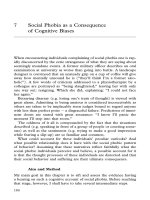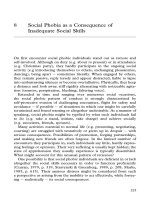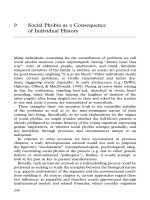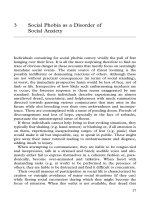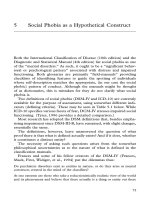Social Phobia - a Self-Protective Interpersonal Pattern
Bạn đang xem bản rút gọn của tài liệu. Xem và tải ngay bản đầy đủ của tài liệu tại đây (96.1 KB, 13 trang )
1 Social Phobia: a Self-Protective
Interpersonal Pattern
What is social phobia? How can it be described? Before attempting that,
it is perhaps well to remember that the ‘‘criteria’’ found in diagnostic
manuals are not depictions of social phobia. Rather, these list its indi-
cators; features considered as particularly prominent, allowing spotting
social phobia À typically from someone’s self-representation. As is the
case with DSM and ICD, in principle there could be several sets of
indicators, potentially all useful (not necessarily to the same degree) in
identifying social phobia.
What conditions ought a description of social phobia satisfy? First, as
an abnormal condition, social phobia has to be a significant behavioral
or psychological pattern associated with considerable distress and
impaired functioning, compromising the ability of such individuals to
pursue desired goals and to participate fully in the life of their
community.
Second, as a phobic pattern it concerns a state of anxious distress in
the face of a looming threat. The state of fright may be widened to
include attempts of the individual to come to grips with it; this straddles
both the somatic and the interpersonal elements.
Third, it ought to give prominence to the social or interpersonal envi-
ronment within which the social phobic pattern is embedded. This is
indispensable because the fearful distress is evoked quite precisely by
specific activities as actually performed or only when imagined in the
presence of others or by interpersonal transactions in which the goals
pursued, namely getting one’s way and gaining approval from others, are
experienced as dangerously unattainable or likely to fail. Finally, to
describe the social phobic pattern is to depict the activity of the whole
human organism, not the workings of a putative system (e.g. state of
mind) or organ (e.g. brain) within it.
A concrete way of representing how persons embody social anxiety
and enact the social phobic pattern is to depict three social phobic
individuals.
3
Case Descriptions
‘‘A’’ was a 47-year-old married woman with two grown-up children from
a previous marriage and unemployed. She described her fears of others
as originating with the death of her father when she was 5 years old. She
felt then very much alone and defenseless. She found her mother domin-
eering, harsh and unresponsive, neglecting her while favoring an older
son. A’s first marriage strengthened these fears as her husband repeat-
edly criticized her appearance and her clumsiness.
When seen, she reported being unable to interview for jobs or go into
a store for fear of blushing and becoming incoherent when addressed
by sales people. She avoided speaking in groups or on the telephone
because of the ‘‘foolish’’ impression she might give, as well as avoiding
public toilets where other women might hear her.
Socially, she was at ease only with her supportive second husband and
grown-up children from the first marriage. She experienced small gath-
erings in which confident-looking and sounding people were present, as
especially intimidating. When speaking about herself she was dispar-
aging and apologized often for various shortcomings. She seldom
expressed opinions, backed away from confrontation, and tended to be
passive. She defied however, her French husband’s insistence to move to
France, on the grounds that her poor vocabulary and French-Canadian
accent would make her a target of ridicule.
A lived (with her husband) in an apartment above that of her mother,
reluctantly looking after the elderly woman who still dominated her. She
approached her mother with trepidation, mostly choosing to do as told
over being criticized sarcastically. The occasional non-compliance was
justified by elaborate excuses repeated many times.
‘‘B’’ was a 32-year-old woman, married and mother to two young
children. While she considered herself as having always been shy, her
difficulties began at the age of 14 when, in the middle of a presentation
of a classroom assignment, she began experiencing a paroxysm of anx-
iety and could not go on. Since that day, she avoided all public speaking
(e.g. classes at university in which this was a requirement).
At work in a bank, she gravitated towards assignments requiring no
meetings or face-to-face contact with clients. She was able to function
within these constraints until becoming pregnant, when she developed
an intense discomfort (‘‘hot in the face’’) in response to the attention
that her pregnancy drew. She then began to dread the possibility of
blushing while being the focus of interest. Gradually the discomfort
generalized to other situations and she began fearing anyone approach-
ing her À especially unexpectedly. At first, she attempted dissimulation
4 What is Social Phobia?
(moving a lot, sitting in dark places) and then avoidance of work (she did
not go back to it after maternity leave) She began progressively to shun
friends and family and apprehended going to the grocery store where
she dreaded the supermarket owner’s greetings and offers of help.
Her husband’s business activities included a certain amount of social-
izing with partners, prospective clients and their spouses in which she
was expected to take part. Her unacknowledged desire to avoid these
was a source of constant friction; nevertheless she successfully hid her
difficulties from her husband in whom she confided only 3 months
before being admitted into treatment. During these outings she feared
silences, being contradicted or queried.
Her relationship with her husband was beset by conflict as she
dissembled by being evasive and ‘‘irresponsible’’ and he often found
fault with her. In retaliation, she rarely expressed affection or apprecia-
tion of things he did or features of his personality. Their sex life was
unsatisfactory. She was similarly stern with her children although much
concerned about them. By contrast, she found it difficult to issue
instructions and otherwise oversee the maid (e.g. criticize her work)
who cleaned her apartment, for fear of blushing.
She set great store by propriety and attempted to achieve perfection
in everything (e.g. appearance, manners). Imperfections of any kind
(blushing, being in therapy) were carefully concealed. Circumstances
in which she fell short of such standards were experienced with disquiet,
especially if other people personified them with seeming ease.
‘‘C’’ was a 35-year-old single man who worked as a machine operator
at a printing plant. He felt always uneasy about meeting new people,
as he would tend to stammer and slur his words initially. This was espe-
cially true in regards to meeting and dating women. At work he was
uneasy in exchanges with the foreman and other people in authority.
He was leading a rather inactive social life but had a small group of
(mostly male) friends with whom he met regularly and whom he accom-
panied on outings to bars. He found it difficult to share intimacies even
with them, and hardly ever spoke of himself (e.g. none was aware of his
fears) or expressed an opinion. He confided only once À in a former
girlfriend.
His most acute fear however, concerned writing, typically signing in
front of others. The onset of this problem could not be established, but
the triggering event took place in a bank. In order to draw money from
his account, C would prepare a check at home and present it to the
teller. On one occasion a teller demanded that he countersign the
check. He argued meekly and inarticulately with the teller with anxiety
mounting. Finally, he complied reluctantly and attempted to sign while
A Self-Protective Interpersonal Pattern 5
in the grip of panic. The teller refused to accept the check and C fled the
bank premises with all eyes fixed on him. Since then he has drawn
money from cash-dispensing machines and made purchases with cash
and readymade checks only. Although wishing to take holidays abroad
he avoided those for fear of trembling while signing, for example, credit-
card slips under scrutiny.
While not as acutely distressing as the inability to write in public, his
loneliness stemming from his fear of approaching available women and
initiating courtship must be considered the most important problem in
the long run.
The Social Phobic Response
Social anxiety or fear À evoked by engaging with others and thereby
submitting to their reactions and scrutiny À is at the heart of the social
phobic pattern of conduct. It involves a looming sense of danger accom-
panied by a heightened activation of the bodily mechanisms supporting
defensive action. Figuratively speaking, social phobic individuals ready
themselves for a desperate flight from or, with every evasive tactic fail-
ing, for a losing struggle with menacing others during various social
interactions. Social anxiety has simultaneously a somatic and an inter-
personal locus.
Somatic: In the face of an emergency, the body is readied for
self-protective action. At such moments, it bustles with intense
activity:
1. Palpitations À the heart pumps faster for the more blood circulates,
the greater the energy. The blood is shifted from the skin to where it is
needed most: muscles and brain. This results in cool extremities and
pallor.
2. Fast breathing À supplies more oxygen.
3. Tensing up of muscles as readying for action occurs; at peak it results
in trembling and incoordination of the hands and a mask-like rigidity
of the face.
4. Sweating À through evaporation it cools off straining muscles.
5. An urge to urinate (in some an inability to do it). Intestinal cramps
and alternating diarrhea and constipation and sometimes vomiting
occur À needless processes in an emergency are aborted and waste
evacuated.
6. Speech difficulties might arise due to labored breathing and inco-
ordination of the muscles involved in articulation (being ‘‘tongue-
tied’’).
6 What is Social Phobia?
7. Otherwise diminished responsiveness and blunted perceptiveness as
vigilance is focused on identifying danger before it arises and reacting
to it as soon as it does.
8. Pupils dilate to increase visual acuity.
9. Hair stands on end. Disappointingly, it is of little use. Unlike cats’
enemies, those of humans are usually not impressed by such displays.
As a consequence, social phobic individuals frequently report neck
and shoulder stiffness and headaches. Ahead of feared situations they
experience palpitations, rapid breathing, tightening of the chest, heat
and sweating, a queasy sensation in the stomach and gut and a pressing
need to have a bowel movement or urinate. Some paradoxically are
unable to relieve themselves in public.
Generally, these individuals describe experiencing an almost unre-
lieved dread, uncertainty and helplessness with much rumination direc-
ted towards guessing various conjunctures that may arise in the future
and what various important people might be thinking of them. All
the while they would also be brooding over their own awkwardness,
unattractiveness, incompetence, and cowardliness. These are beheld
with a sense of impending doom. Periods of discouragement and hope-
lessness, especially following setbacks, punctuate a fluctuating but unin-
terrupted sense of menace.
Some social phobic individuals dread blushing. Although this redden-
ing of the face, ears, neck, and upper chest is a psychosomatic manifes-
tation, it is not one of anxiety. Blanching rather than blushing prevails
in fear. The facial expressions accompanying blushing (e.g. smiling,
averting one’s gaze and lowering one’s head) are unlike the strained
vigilance typical of fear. Finally, blushing occurs in a state of passivity
and immobility, in contrast to the restlessness and agitation common
to anxious states. Consequently, I shall consider blushing as a facet of
a wider interpersonal pattern to be discussed below.
All anxious disorders might be said to involve an exacerbation of
the above normal ‘‘stress-response,’’ chronically extended. Social
phobia is marked off from other such anxious states by the insistent
attempts of such individuals to hide the physical manifestations of fear
from the critical gaze of others. Some adopt a disguise: dark glasses,
wide-brimmed hats, make-up, and turtlenecks to conceal blushing for
example. The surest means to safety however, is keeping a distance
from danger (i.e. avoiding evocative social occasions altogether or, if it
cannot be helped, escaping) and hiding (i.e. remaining out of sight) or
not drawing attention (e.g. saying little). As the cumulative social cost
of such actions might be very high indeed (e.g. none are compatible
A Self-Protective Interpersonal Pattern 7



